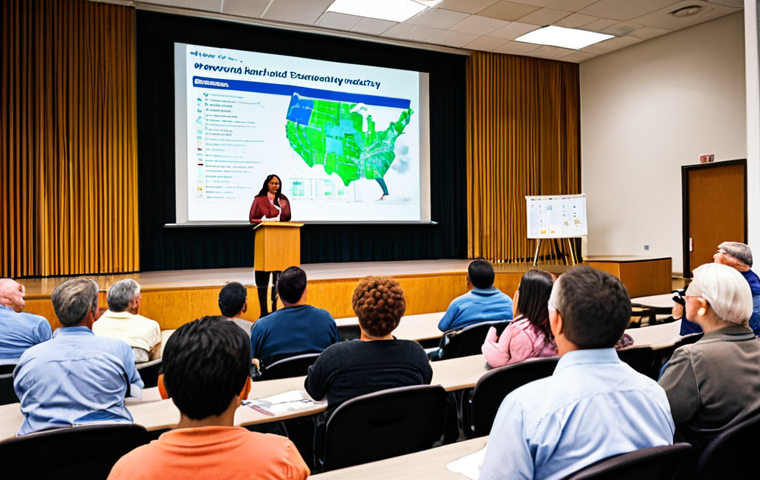Ever wonder what it truly takes to safeguard our planet while climbing the corporate ladder? I’ve always been fascinated by the blend of environmental science and strategic business decisions.
From what I’ve seen, environmental management experts are becoming increasingly crucial. Their roles go beyond simple compliance; they’re actively shaping sustainable practices and ensuring future resilience within organizations.
As environmental awareness grows, so does the demand for professionals who can navigate this complex landscape. The field is evolving, integrating advanced technologies and innovative strategies to minimize environmental impact.
Let’s dive deeper into the details in the article below!
Here is your blog post:
Decoding the Core Responsibilities of an Environmental Management Expert

Let’s face it, the job title “Environmental Management Expert” sounds incredibly broad, right? I always wondered exactly what they *do* all day. Well, after shadowing a few and digging into industry specifics, I’ve found it boils down to a few key areas. First, they’re the strategists – figuring out how a company can meet environmental regulations while also staying profitable. It’s a tightrope walk, balancing ecological responsibility with economic realities. Think about a manufacturing plant; an expert will analyze their waste streams, emissions, and resource consumption to propose improvements that reduce environmental impact and save money. It’s about finding those sweet spots where being green is also good for the bottom line. From my experience, one of the most challenging aspects is navigating the ever-changing landscape of environmental laws. What’s compliant today might not be tomorrow, so staying updated and proactive is critical.
Navigating Regulatory Frameworks
Environmental regulations are a maze, honestly. These experts need to be fluent in local, national, and sometimes international laws. It’s not just about knowing the rules, but also understanding how they apply to specific industries and operations. For instance, a construction company will have different regulatory hurdles than a tech firm. I once saw an expert untangle a mess of conflicting regulations for a renewable energy project, allowing it to move forward while avoiding hefty fines. They often work with legal teams to ensure everything is airtight.
Implementing Sustainable Practices
This is where the real action happens! It’s about translating regulations and best practices into tangible actions. This might involve designing waste reduction programs, implementing energy-efficient technologies, or developing sustainable sourcing strategies. I’ve noticed that the most effective experts aren’t just advisors; they’re also change agents, motivating employees and stakeholders to adopt new behaviors. A memorable example was when an expert introduced a comprehensive recycling program at a large office complex, complete with employee training sessions and incentives. Within months, waste going to landfills was reduced by over 50%.
The Tech Toolkit: Essential Skills for Environmental Management Pros
It’s not just about knowing environmental science. These experts are increasingly relying on technology. When I first got into this field, spreadsheets were the go-to tool, but now, Geographic Information Systems (GIS), environmental modeling software, and data analytics platforms are essential. GIS, for instance, helps visualize environmental data and assess potential impacts of projects. Modeling software can predict the spread of pollutants or the effectiveness of remediation efforts. And data analytics helps identify trends, optimize resource use, and track progress towards sustainability goals. Let’s be real, staying updated with the latest tech is critical for staying competitive. The field is evolving rapidly, and those who embrace new tools will be much more effective.
Leveraging Data Analytics for Sustainability
Data is king! Environmental management experts use data analytics to monitor environmental performance, identify areas for improvement, and track progress towards sustainability goals. This involves collecting and analyzing data on energy consumption, waste generation, emissions, and other relevant metrics. For example, an expert might use data analytics to identify patterns in energy usage at a manufacturing facility and then develop strategies to reduce consumption during peak hours.
GIS and Environmental Modeling
GIS software allows experts to map environmental data and assess the potential impacts of projects on sensitive ecosystems. Environmental modeling software helps predict the spread of pollutants, evaluate the effectiveness of remediation strategies, and assess climate change impacts. I saw firsthand how one expert used GIS to map the potential impacts of a proposed highway on a local wetland, which helped the project team identify alternative routes that minimized environmental damage.
The Art of Communication: Engaging Stakeholders and Building Consensus
Being an environmental management expert isn’t just about crunching numbers and understanding regulations. It’s also about communicating effectively with diverse stakeholders. From C-suite executives to frontline employees, community members to government officials, you need to be able to explain complex environmental issues in a way that resonates with each audience. That means tailoring your message, using clear and concise language, and actively listening to concerns. I remember when I was involved in a project where the public was skeptical about a new waste treatment facility. The environmental management expert took the time to meet with community groups, answer their questions, and address their concerns. By building trust and fostering open communication, they were able to gain community support for the project.
Crafting Effective Environmental Reports
A core skill for any environmental management expert is the ability to write clear and concise reports. These reports summarize environmental assessments, track progress toward sustainability goals, and document compliance with regulations. Think of them as your evidence to the outside world. I learned quickly that reports should be tailored to the intended audience, using language that is easy to understand and avoiding technical jargon. Clear and visually appealing reports can be instrumental in securing funding, gaining regulatory approvals, and building stakeholder support.
Public Speaking and Community Engagement
Environmental management experts often need to present information to public audiences, such as community meetings, industry conferences, or government hearings. This requires strong public speaking skills and the ability to handle tough questions. I watched a colleague give an environmental impact presentation at a town hall and was impressed by how he was able to communicate complex scientific data in a clear and engaging manner. He addressed people’s concerns and was able to reassure the residents.
Risk Assessment and Mitigation: Protecting People and the Planet
A critical aspect of environmental management is identifying and assessing environmental risks. This involves evaluating the potential impacts of industrial activities, development projects, and natural hazards on human health and the environment. Once risks are identified, experts develop strategies to mitigate those risks and prevent accidents or environmental damage. Think of a chemical plant: an expert will assess the potential risks of chemical spills, fires, or explosions and then develop emergency response plans, safety protocols, and containment measures. I’ve seen this in action, where early identification of potential risks averted costly accidents. It’s about proactive planning and prevention.
Performing Environmental Impact Assessments
Environmental Impact Assessments (EIAs) are a key tool for evaluating the potential environmental impacts of proposed projects. These assessments involve a thorough review of potential impacts on air, water, soil, wildlife, and human communities. As someone who’s worked on a few EIAs, I can say that they require a multidisciplinary approach, involving experts in ecology, hydrology, geology, and other relevant fields. The goal is to identify potential risks and develop mitigation measures to minimize environmental damage.
Developing Emergency Response Plans
Even with the best prevention measures, accidents can happen. Environmental management experts develop emergency response plans to address potential spills, releases, or other environmental emergencies. These plans outline the steps to be taken to contain the incident, protect human health, and minimize environmental damage. I think of it like a fire drill, but for environmental disasters. They require coordination with local authorities, emergency responders, and community stakeholders. These plans can be crucial in minimizing the impact of unforeseen events.
The Ethical Compass: Integrity and Responsibility in Environmental Management
Let’s be honest, environmental management isn’t just about following rules and regulations. It’s also about making ethical decisions and taking responsibility for the environmental consequences of our actions. I believe that environmental management experts have a duty to act in the best interests of both people and the planet, even when it’s not the easiest or most profitable path. This means being transparent, honest, and accountable for our decisions. I remember a situation where an expert discovered that a company was violating environmental regulations but was pressured to keep quiet. The expert chose to report the violation, even though it meant risking their job. That’s the kind of integrity that defines a true environmental management professional. Because, in the end, we all want to leave a good legacy.
Promoting Environmental Stewardship
Environmental stewardship is the concept of taking responsibility for the environment and managing resources sustainably. Environmental management experts promote environmental stewardship by educating employees, stakeholders, and the public about environmental issues and encouraging them to adopt sustainable practices. From my experience, this involves community outreach, educational programs, and volunteer initiatives.
Navigating Ethical Dilemmas
Ethical dilemmas are common in the field of environmental management. Experts often face difficult decisions where there are conflicting interests or no clear-cut answers. In these situations, it’s important to consider the ethical implications of each decision and to act in a way that is consistent with our values and principles. I think it’s about asking yourself, “What is the right thing to do for the environment and the community?”
Career Pathways and Opportunities: Charting Your Course in Environmental Management
The field of environmental management offers diverse career opportunities. From consulting firms to government agencies, non-profit organizations to private companies, there are roles for professionals with a passion for environmental sustainability. Common job titles include environmental consultant, environmental engineer, sustainability manager, and environmental scientist. I often get asked what educational background is needed. Typically, a bachelor’s or master’s degree in environmental science, engineering, or a related field is required. Professional certifications, such as the Certified Environmental Professional (CEP) designation, can also enhance career prospects.
Consulting vs. In-House Roles
Environmental management experts can work as consultants, providing services to a variety of clients, or they can work in-house for a specific company or organization. Consulting roles offer the opportunity to work on diverse projects and gain experience in different industries. In-house roles provide stability and the chance to focus on a specific organization’s environmental performance. A friend of mine who works as a consultant enjoys the variety of projects she gets to work on, while another friend who works in-house appreciates the stability and opportunity to make a long-term impact on her company’s sustainability initiatives.
Emerging Trends and Specializations
The field of environmental management is constantly evolving, with new trends and specializations emerging all the time. Some of the most promising areas include renewable energy, green building, sustainable agriculture, and circular economy. Experts in these areas are in high demand as organizations seek to reduce their environmental footprint and embrace sustainable practices. I’ve seen the rise of “sustainability officers” as a critical new role within many major companies.
Measuring Success: Key Performance Indicators in Environmental Management
How do we know if our environmental management efforts are making a difference? The answer lies in Key Performance Indicators (KPIs). These are measurable metrics that track progress towards environmental goals. Common KPIs include energy consumption, water usage, waste generation, greenhouse gas emissions, and regulatory compliance. The key is to choose KPIs that are relevant to your organization’s specific activities and goals. For example, a manufacturing company might track its energy consumption per unit of production, while a city might track its recycling rate. These metrics provide a clear and objective way to assess environmental performance and identify areas for improvement. What I’ve experienced is that tracking and communicating these metrics to stakeholders is essential for demonstrating accountability and building trust.
Setting SMART Environmental Goals
SMART goals are Specific, Measurable, Achievable, Relevant, and Time-bound. When setting environmental goals, it’s important to make them SMART. For example, instead of saying “We want to reduce our energy consumption,” a SMART goal would be “We will reduce our energy consumption by 15% by the end of next year.” This provides a clear target, a way to measure progress, and a deadline for achievement.
Reporting and Disclosure
Transparency is key in environmental management. Organizations are increasingly disclosing their environmental performance to stakeholders through sustainability reports, environmental certifications, and public disclosures. These reports provide information on environmental impacts, sustainability initiatives, and progress toward goals. I can tell you that reporting and disclosure is not just about complying with regulations; it’s also about building trust with customers, investors, and communities.
| Area of Expertise | Key Skills | Common Tasks | Relevant Technologies |
|---|---|---|---|
| Regulatory Compliance | Knowledge of environmental laws, attention to detail | Ensuring compliance with regulations, conducting audits | Regulatory databases, compliance tracking software |
| Waste Management | Waste reduction strategies, recycling techniques | Developing waste management plans, optimizing recycling programs | Waste tracking systems, materials recovery facilities |
| Environmental Impact Assessment | Data analysis, report writing, GIS | Conducting environmental assessments, writing impact reports | GIS software, environmental modeling tools |
| Sustainability Management | Strategic planning, communication, stakeholder engagement | Developing sustainability strategies, engaging stakeholders | Data analytics platforms, sustainability reporting software |
In Conclusion
Becoming an Environmental Management Expert is a challenging yet incredibly rewarding career path. It’s not just about knowing the science; it’s about problem-solving, communicating, and making ethical decisions. If you’re passionate about protecting the environment and making a positive impact, this field offers a chance to do just that. The road may be complex, but the destination – a healthier planet – is well worth the journey.
Handy Information to Keep in Your Back Pocket
1. Stay updated on environmental laws and regulations through resources like the EPA website or industry-specific publications.
2. Network with other environmental professionals at conferences and workshops, like the annual NAEM event.
3. Consider pursuing professional certifications, such as the Certified Environmental Professional (CEP) or LEED accreditation.
4. Familiarize yourself with the latest environmental technologies, like GIS software and data analytics platforms. Look into free trials or educational licenses.
5. Practice your communication skills by giving presentations to community groups or writing articles for local publications. Even volunteering counts!
Key Takeaways
Environmental Management Experts wear many hats: strategist, scientist, communicator, and ethical decision-maker. Success requires a blend of technical skills, soft skills, and a strong commitment to environmental stewardship. By staying updated on regulations, embracing new technologies, and engaging stakeholders, you can make a real difference in protecting people and the planet.
Frequently Asked Questions (FAQ) 📖
Q: What exactly does an environmental management expert do, like on a day-to-day basis?
A: Well, from what I’ve gathered from friends in the field, it’s a real mixed bag! One day they might be analyzing emissions data to ensure a company is meeting EPA standards, another they might be advising on waste reduction strategies or even leading a company-wide training on sustainable practices.
I know a guy who spent a week in Louisiana helping a chemical plant revamp their wastewater treatment system – pretty hands-on stuff! A lot of it is about figuring out how to make being “green” also make good business sense.
Q: Is a specific degree absolutely necessary to get into environmental management, or are there other paths?
A: While a degree in environmental science, engineering, or a related field is definitely a plus, it’s not the only way in. I’ve seen people transition from project management or even finance if they can demonstrate a solid understanding of environmental regulations and a passion for sustainability.
Certifications like the Certified Environmental Professional (CEP) can really boost your credibility, too. Bottom line, a combination of education, relevant experience, and those key certifications can get your foot in the door.
My neighbor started as a volunteer with a local conservation group and worked his way up – so determination counts for a lot!
Q: How do you actually measure the impact of environmental management efforts – isn’t it all a bit…abstract?
A: Great question! It’s not all abstract at all, actually. Companies use a range of metrics, like tracking their carbon footprint, water usage, and waste generation.
They set targets, and then they measure their progress against those benchmarks. For example, a retailer might aim to reduce plastic packaging by 20% in a year.
They can quantify how much less plastic they’re using, and that directly translates to a smaller environmental impact. It’s all about setting tangible goals and using data to track improvements.
I even saw a report from a local brewery that detailed exactly how much water they saved by implementing a new recycling system – very concrete stuff.
📚 References
Wikipedia Encyclopedia
구글 검색 결과
구글 검색 결과
구글 검색 결과
구글 검색 결과
구글 검색 결과






